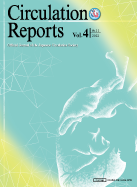Volume 4, Issue 11
Displaying 1-11 of 11 articles from this issue
- |<
- <
- 1
- >
- >|
Original Articles
Cardiac Rehabilitation
-
Article type: ORIGINAL ARTICLE
Subject area: Cardiac Rehabilitation
2022Volume 4Issue 11 Pages 505-516
Published: November 10, 2022
Released on J-STAGE: November 10, 2022
Advance online publication: October 18, 2022Download PDF (1180K) Full view HTML
Cardiovascular Intervention
-
Article type: ORIGINAL ARTICLE
Subject area: Cardiovascular Intervention
2022Volume 4Issue 11 Pages 517-525
Published: November 10, 2022
Released on J-STAGE: November 10, 2022
Advance online publication: October 13, 2022Download PDF (1364K) Full view HTML
Heart Failure
-
Article type: ORIGINAL ARTICLE
Subject area: Heart Failure
2022Volume 4Issue 11 Pages 526-532
Published: November 10, 2022
Released on J-STAGE: November 10, 2022
Advance online publication: October 04, 2022Download PDF (904K) Full view HTML
Peripheral Vascular Disease
-
Article type: ORIGINAL ARTICLE
Subject area: Peripheral Vascular Disease
2022Volume 4Issue 11 Pages 533-541
Published: November 10, 2022
Released on J-STAGE: November 10, 2022
Advance online publication: September 23, 2022Download PDF (963K) Full view HTML
Pulmonary Circulation
-
Article type: ORIGINAL ARTICLE
Subject area: Pulmonary Circulation
2022Volume 4Issue 11 Pages 542-549
Published: November 10, 2022
Released on J-STAGE: November 10, 2022
Advance online publication: October 08, 2022Download PDF (551K) Full view HTML
Protocol Papers
-
Article type: PROTOCOL PAPER
2022Volume 4Issue 11 Pages 550-554
Published: November 10, 2022
Released on J-STAGE: November 10, 2022
Advance online publication: October 15, 2022Download PDF (1559K) Full view HTML
Images in Cardiovascular Medicine
-
Article type: IMAGES IN CARDIOVASCULAR MEDICINE
2022Volume 4Issue 11 Pages 555-556
Published: November 10, 2022
Released on J-STAGE: November 10, 2022
Advance online publication: October 08, 2022Download PDF (963K) Full view HTML -
Article type: IMAGES IN CARDIOVASCULAR MEDICINE
2022Volume 4Issue 11 Pages 557-558
Published: November 10, 2022
Released on J-STAGE: November 10, 2022
Advance online publication: October 12, 2022Download PDF (582K) Full view HTML
Letters to the Editor
-
Article type: LETTER TO THE EDITOR
2022Volume 4Issue 11 Pages 559-
Published: November 10, 2022
Released on J-STAGE: November 10, 2022
Advance online publication: October 21, 2022Download PDF (302K) Full view HTML -
Article type: AUTHOR’S REPLY
2022Volume 4Issue 11 Pages 560-561
Published: November 10, 2022
Released on J-STAGE: November 10, 2022
Advance online publication: October 21, 2022Download PDF (324K) Full view HTML
-
2022Volume 4Issue 11 Pages Content11-
Published: November 10, 2022
Released on J-STAGE: November 10, 2022
Download PDF (688K)
- |<
- <
- 1
- >
- >|
